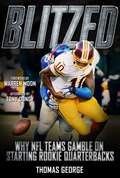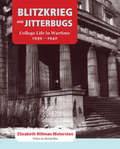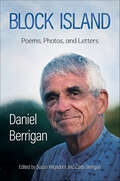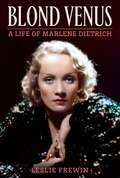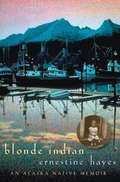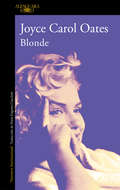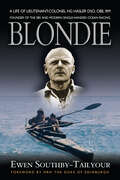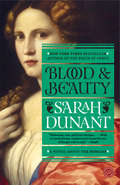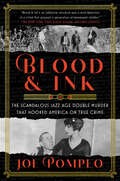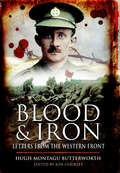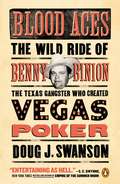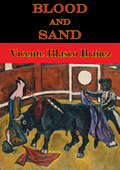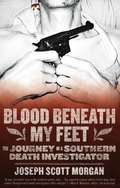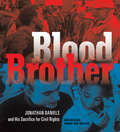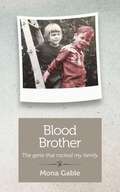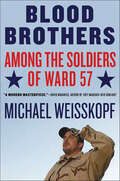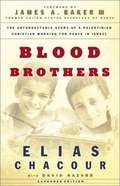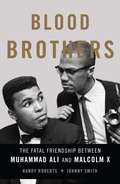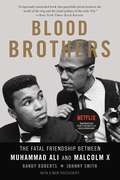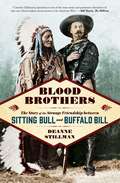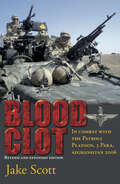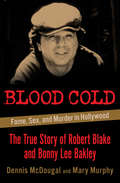- Table View
- List View
Blitzed: Why NFL Teams Gamble on Starting Rookie Quarterbacks
by Tony Dungy Warren Moon Thomas GeorgeIn today’s NFL, every team has a “win now” mentality. There’s no time for rebuilding or down years. You need to compete each and every day, or else you’re out; and that goes for the players, coaches, and front office. You either win today or you’re gone tomorrow.Because of this trend, struggling teams have forgone the training of old and slowly building from the ground up for the immediate payoff. And when it comes to gaining the interest of the fans and media, there’s one go-to decision for every struggling team: the rookie quarterback.Blitzed is an in-depth study as to the reason why teams choose to hand the keys of their franchise over to an unproven rookie. But there are multiple layers as to the odds of success for these athletes. While much has to do with their mental and physical toughness, the coaching, front office, and state of an organization all play a crucial role.In the last two NFL drafts, quarterbacks have been taken as the first two picks (Jameis Winston and Marcus Mariota in 2015; Jared Goff and Carson Wentz in 2016). The face of the franchise can’t grow a beard, but is expected to lead his team on the gridiron. Covering the history of this trend with a running timeline of the 2016 NFL season and top draft picks Goff and Wentz, as well as interviews with numerous current and former quarterbacks, coaches, and executives, distinguished journalist Thomas George breaks down how teams decide on starting a rookie quarterback and why the chances of an immediate payoff are such a mixed bag.
Blitzkrieg and Jitterbugs: College Life in Wartime, 1939-1942 (Footprints Series #28)
by Elizabeth Hillman WaterstonElizabeth Hillman enrolled at McGill University the week World War II began. As a freshman writing for the McGill Daily, she covered torchlight football parades and dances at the Ritz Carleton hotel while elsewhere the paper reported U-boats torpedoing convoys and war planes plummeting into the British channel. Blitzkrieg and Jitterbugs draws on her journal entries, articles from the Daily, and headlines from the Montreal Gazette to paint a vivid picture of day-to-day life on campus, alongside the civilian wartime experience in Canada. Part memoir, part history, the book touches on important feminist issues of the day, provides historical detail on both McGill University and Canada's participation in World War II, and is punctuated with candid glimpses into both the social and intellectual aspects of university life during a three-year tenure at McGill. Charmingly written with subtle ironies, Blitzkrieg and Jitterbugs includes photos collected from scrapbooks, albums, and the McGill archives to vividly highlight aspects of wartime life as experienced far from the battlefields.
Block Island: Poems, Photos, and Letters
by Daniel BerriganA Voice and a Poet for All Times It is impossible not to be gripped by the spectacular details of Daniel Berrigan's life. He was Paul Simon's "radical priest" smiling in handcuffs. The Jesuit activist excommunicated by his peers and imprisoned by the state. The unapologetic advocate for society's disempowered. The defiant vandal of objects that fed bodies and materiel to the war machine. And the earnest, yet somehow serene, face emanating from televisions denouncing the inhumanity of that very machine's deeds. Yet Daniel was first an accomplished poet, inspired in his faith by dreams of peace. It was from this profound contemplation of the world from an early age that his courageous acts of civil disobedience and humanitarianism were born. In this collection of interconnected poems, Daniel Berrigan writes about his intimate bond with his small cottage built especially for him on Block Island. We see his complete integration into the island itself in his reverence for the everyday life and ever-changing weather winding around him. Yet soon we also discover themes of God and the soul, the land and the sea, friendship and loss, time and impermanence, and the tension between society's potential and its spiritual impoverishment. Embraced by personal and scholarly writings from friends who remain students of Daniel's ideas and lifeworks, as well as images and letters that enrich our perceptions of Daniel, this ever-timely collection is an essential object for poets, activists, the faithful, and all forms of countercultural rebel alike.
Blond Venus: A Life of Marlene Dietrich
by Leslie FrewinBlond Venus, first published in 1956, is a look at the life and work of German-American screen legend Marlene Dietrich (1901-1992). From Dietrich’s childhood in Berlin to her success in Europe and Hollywood, Blond Venus portrays largely the public life and career of Dietrich; her private life was carefully guarded, and although described in the book, would require later biographies to paint a fuller picture (including the biography prepared by her daughter, Maria Riva). Included are 23 pages of photographs and a screen discography through 1952.
Blonde
by Joyce Carol OatesFrom her days as an orphan sent from foster home to foster home to the days when she was President John F. Kennedy's companion, this is a fictionalized account of Marilyn Monroe.
Blonde Indian: An Alaska Native Memoir
by Ernestine HayesBorn in Juneau, Alaska, Ernestine Hayes (English, U. of Alaska Southeast) is a member of the Wolf House of the Kaagwaantaan clan of the Lingit. In this memoir, she uses vivid dialogue to tell the story of her girlhood, her travels as a young woman, and her return home as an adult. She also reveals her inner struggle as an individual who is neither fully Native American nor Euro-American.
Blonde: A Novel (Ldp Litterature Ser.)
by Joyce Carol Oates«Oates sabe que ya has visto a Marilyn Monroe. La reconocerías en cualquier parte. Tantas imágenes, tantas historias que ya han echado raíces en tu mente. Pero su fuerza y su talento consiste en limitarse a señalar los detalles y traerla de vuelta a la vida, a ella y a todo el siglo: la muchacha desnuda, el terciopelo rojo, las plantas de sus pies.»Bethany Schneider, Newsday «Socorro, siento que la Vida se acerca.» Marilyn Monroe era puro fuego, sexualidad a flor de piel, romances turbulentos; pero también era frágil, una mujer asustada y repleta de inseguridades que buscaba en otros -el Ex Deportista, el Dramaturgo o el Presidente- ese amor que ella misma se negaba. Una artista emblemática cargada de conflictos y temores, de pasiones desatadas; una niña que no dejó de huir hacia delante, y llegó a burlar a la propia muerte para convertirse en leyenda. Tras una exhaustiva documentación, Joyce Carol Oates redibuja la vida interior de Norma Jeane Baker -la pequeña sin padre, la mujer dependiente de tranquilizantes y estimulantes, la malograda actriz y amante- y a su «Amiga Mágica del Espejo», la idolatrada rubia que el mundo llegó a conocer como Marilyn Monroe. ** Premio Ja! Bilbao por el «modernísimo humor negro» de su obra. La crítica ha dicho...«Dramática, provocativa e inquietantemente sugerente, Blonde es tan explosiva como su protagonista, la legendaria Marilyn Monroe. En una prosa impresionista de elevada potencia, Oates crea un retrato sorprendente y conmovedor de la estrella mítica y de la sociedad que la creó y le falló.»Publishers Weekly «Oates nos hace vivir la vida de Marilyn Monroe. Y es un verdadero infierno. Y es brillante. Porque nos querremos arrancar los ojos para dejar de mirar, y es imposible.»Ann Patchett, The Times «Oates rebosa testosterona, y su último libro es agresivo y atrevido. Quiere que miremos a un personaje mítico con nuevos ojos, pero no con los de la cámara, sino con nuestros ojos más humanos.»Philip Weiss, New York Observer «En lo referente a Marilyn Monroe, el público siempre se quedaba en el exterior y miraba hacia el interior, pero he aquí que en esta nueva y apasionante novela, Blonde, Joyce Carol Oates revierte ese proceso al plantarse en el interior de la torturada psique de la actriz para rematar un retrato perturbadoramente íntimo.»John Thomas, Playboy «Oates se libera de los corsés de una renarración periodística de hechos archiconocidos y crea con verdadera maestría una potente tragedia norteamericana profundamente inquietante.»Susan Tekulve, Book Magazine «Una novela que nos va ganando y absorbiendo a medida que vamos pasando las páginas hasta seducirnos por completo.»Jason S. Polley, Revista Arcadia «Un libro potente e hipnótico.»Elaine Showalter, Literary Review «La obra más importante de la prolífica carrera de Oates.»Dan Cryer, Newsday «Una magnífica obra, escrita con parte de esa frenética inspiración con la que Marilyn Monroe vivió su vida. Si no ha leído aún a Joyce Carol Oates, no lo deje por más tiempo. Empiece aquí y ahora.»Susan Jeffreys, The Independent
Blondie: A Life of Lieutenant-Colonel HG Hasler DSO,OBE, RM
by Ewen Southby-TailyourBlondie Hasler was the leader of the famous 'Cockleshell Heroes'. He designed the canoes which were used in the operation, he recruited and trained the twelve men who made up this most secret team and led them on their daring mission, code name 'Operation Frankton', to attack enemy shipping in Bordeaux harbor. He was one of only two 'Cockleshell Heroes' who came back alive, the other being Bill Sparks, his partner in the cockleshell Catfish. His story is told by former Royal Marine, Ewen Southby- Tailyour. The story of how Blondie managed to make contact with the Maquis once he and Sparks had completed the mission is well worth a book in itself. Although the book offers a new insight into the men that were the 'Cockleshell Heroes' Blondie Hasler was more than just a 'Cockleshell Hero'. Ewen Southby- Tailyour has been given full access to family archive material, which reveals Herbert George Hasler as an extraordinary figure who makes this one of the outstanding biographies of the year.
Blood & Beauty
by Sarah DunantThe New York Times bestselling author of the acclaimed Italian Renaissance novels--The Birth of Venus, In the Company of the Courtesan, and Sacred Hearts--has an exceptional talent for breathing life into history. Now Sarah Dunant turns her discerning eye to one of the world's most intriguing and infamous families--the Borgias--in an engrossing work of literary fiction. By the end of the fifteenth century, the beauty and creativity of Italy is matched by its brutality and corruption, nowhere more than in Rome and inside the Church. When Cardinal Rodrigo Borgia buys his way into the papacy as Alexander VI, he is defined not just by his wealth or his passionate love for his illegitimate children, but by his blood: He is a Spanish Pope in a city run by Italians. If the Borgias are to triumph, this charismatic, consummate politician with a huge appetite for life, women, and power must use papacy and family--in particular, his eldest son, Cesare, and his daughter Lucrezia--in order to succeed. Cesare, with a dazzlingly cold intelligence and an even colder soul, is his greatest--though increasingly unstable--weapon. Later immortalized in Machiavelli's The Prince, he provides the energy and the muscle. Lucrezia, beloved by both men, is the prime dynastic tool. Twelve years old when the novel opens, hers is a journey through three marriages, and from childish innocence to painful experience, from pawn to political player. Stripping away the myths around the Borgias, Blood & Beauty is a majestic novel that breathes life into this astonishing family and celebrates the raw power of history itself: compelling, complex and relentless.
Blood & Ink: The Scandalous Jazz Age Double Murder That Hooked America on True Crime
by Joe PompeoNew York Times Editor's Pick & Best True Crime of 2022“Blood & Ink is among 2022’s best works of true crime.” —Washington PostVanity Fair’s Joe Pompeo investigates the notorious 1922 double murder of a high-society minister and his secret mistress, a Jazz Age mega-crime that propelled tabloid news in the 20th century.On September 16, 1922, the bodies of Reverend Edward Hall and Eleanor Mills were found beneath a crabapple tree on an abandoned farm outside of New Brunswick, New Jersey. The killer had arranged the bodies in a pose conveying intimacy.The murder of Hall, a prominent clergyman whose wife, Frances Hall, was a proud heiress with illustrious ancestors and ties to the Johnson & Johnson dynasty, would have made headlines on its own. But when authorities identified Eleanor Mills as a choir singer from his church married to the church sexton, the story shocked locals and sent the scandal ricocheting around the country, fueling the nascent tabloid industry. This provincial double murder on a lonely lover’s lane would soon become one of the most famous killings in American history—a veritable crime of the century. The bumbling local authorities failed to secure any indictments, however, and it took a swashbuckling crusade by the editor of a circulation-hungry Hearst tabloid to revive the case and bring it to trial at last.Blood & Ink freshly chronicles what remains one of the most electrifying but forgotten murder mysteries in U.S. history. It also traces the birth of American tabloid journalism, pandering to the masses with sordid tales of love, sex, money, and murder.
Blood & Iron: Letters from the Western Front
by Hugh Montagu ButterworthUntil now Hugh Butterworth was just one of the millions of lost soldiers of the Great War, and the extraordinary letters he sent home from the Western Front have been forgotten. But after more than ninety years of obscurity, these letters, which describe his experience of war in poignant detail, have been rediscovered, and they are published here in full. They are a moving, intensely personal and beautifully written record by an articulate and observant man who witnessed at first hand one of the darkest episodes in European history. In civilian life Butterworth was a dedicated and much-loved schoolmaster and a gifted cricketer, who served with distinction as an officer in the Rifle Brigade from the spring of 1915. His letters give us a telling insight into the thoughts and reactions of a highly educated, sensitive and perceptive individual confronted by the horrors of modern warfare. He was killed on the Bellewaarde ridge near Ypres on 25 September 1915, and his last letter was written on the eve of the action in which he died.
Blood Aces
by Doug SwansonThe astonishing story of Benny Binion--a rip-roaring saga of murder, money, and the making of Las Vegas Benny Binion was many things: a cowboy, a pioneering casino owner, a gangster, a killer, and founder of the hugely successful World Series of Poker. Blood Aces tells the story of Binion's crucial role in shaping modern Las Vegas. From a Texas backwater, Binion rose to prominence on a combination of vision, determination, and brutal expediency. His formula was simple: run a good business, cultivate the big boys, kill your enemies, and own the cops. Through a mix of cold-bloodedness, native intelligence, folksiness, and philanthropy, Binion became one of the most revered figures in the history of gambling, and his showmanship, shrewdness, and violence would come to dominate the Vegas scene. Veteran journalist Doug J. Swanson uses once-secret government documents and dogged reporting to show how Binion destroyed his rivals and outsmarted his adversaries--including J. Edgar Hoover. As fast paced as any thriller, Blood Aces tells a story that is unmatched in the annals of American criminal justice, a vital yet untold piece of this country's history.
Blood Aces
by Doug SwansonThe astonishing story of Benny Binion--a rip-roaring saga of murder, money, and the making of Las Vegas Benny Binion was many things: a cowboy, a pioneering casino owner, a gangster, a killer, and founder of the hugely successful World Series of Poker. Blood Aces tells the story of Binion's crucial role in shaping modern Las Vegas. From a Texas backwater, Binion rose to prominence on a combination of vision, determination, and brutal expediency. His formula was simple: run a good business, cultivate the big boys, kill your enemies, and own the cops. Through a mix of cold-bloodedness, native intelligence, folksiness, and philanthropy, Binion became one of the most revered figures in the history of gambling, and his showmanship, shrewdness, and violence would come to dominate the Vegas scene. Veteran journalist Doug J. Swanson uses once-secret government documents and dogged reporting to show how Binion destroyed his rivals and outsmarted his adversaries--including J. Edgar Hoover. As fast paced as any thriller, Blood Aces tells a story that is unmatched in the annals of American criminal justice, a vital yet untold piece of this country's history.
Blood And Sand
by Mrs W. A. Gillespie Vicente Blasco IbañezVincente Blasco Ibanez in Blood and Sand, wrote a novel that can never lose its popularity because it presents a blazing picture of Spanish life as it can be lived only in Spain. A life that was flaming, tempestuous, fierce and magnificent while it lasted a life of heroes and idol worship, of hate and love in a setting of gorgeous beauty. It is the story of one of the world's most fearless men -- men who defy death in the arena for love and fame.From the lowest ranks of poverty to unprecedented heights of riches and popular acclaim--thus was the career of Juan Gallardo, Spanish bull fighter. In telling his story, Ibanez has achieved a novel even more dramatic and powerful than his legendary Four Horsemen. From his boyhood Juan longed to be a bull fighter and, as he climbs the ladder step by step, the reader lives with him in the very atmosphere of the arena. No detail of the picture is spared--one can see and almost hear the actual battle--the crowds--the many characters that stream through the pages. And Juan himself, with his vanities, his superstitions, his daring attacks, his wounds and recoveries, emerges as real, vital and colorful as the sport to which he and many others dedicated their lives.
Blood Beneath My Feet
by Joseph Scott MorganHave you ever been locked in a cooler with piles of decomposing humans for so long that you had to shave all the hair off your body in order to get rid of the smell? Joseph Scott Morgan did. Have you ever lit a Marlboro from the ignited gas of a bloated dead man's belly? Joseph Scott Morgan has. Have you ever wept over a dead dog while not giving a shit about the dead owner laying next him? Morgan did. Were you named after a murder victim? Joseph Scott Morgan was. This isn't Hollywood fantasy--it's the true story of a boy born into the deprivations of a white trash trailer park who as an adult gets further involved in the desperate backdoor sagas of the "new South." No hot blondes here, just maggots, grief, and the truth about forensics and death investigation. Joseph Scott Morgan became a death investigator with the Jefferson Parish Coroner's Office in suburban New Orleans in 1987, the youngest medicolegal death investigator in the country. During the day, Morgan worked in the morgue, and at night investigated for the coroner. In 1992 Morgan became senior investigator with the Fulton County Medical Examiner's Office in Atlanta. Morgan is now a college professor at North Georgia College and State University, where he teaches a death investigation course based on the national standards which he helped develop. He and his family reside in the Blue Ridge Mountains of north Georgia.
Blood Brother: 33 Reasons My Brother Scott Peterson Is Guilty
by Anne BirdA woman who was given up for adoption at birth, meets her biological family, only to discover her newfound brother, Scott Peterson, is a killer. Soon after her birth in 1965, Anne was given up for adoption by her mother, Jackie Latham. Welcomed into the well-adjusted Grady family, she lived a happy life. Then, in the late 1990s, she came back into contact with her mother, now Jackie Peterson, and her family—including Jackie's son Scott Peterson and his wife, Laci. Anne was welcomed into the family, and over the next several years she grew close to Scott and especially Laci. Together they shared holidays, family reunions, and even a trip to Disneyland. Anne and Laci became pregnant at roughly the same time, and the two became confidantes.Then, on Christmas Eve 2002, Laci Peterson went missing—and the happy façade of the Peterson family slowly began to crumble. Anne rushed to the family's aid, helping in the search for Laci, even allowing Scott to stay in her home while police tried to find his wife. Yet Scott's behavior grew increasingly bizarre during the search, and Anne grew suspicious that her brother knew more than he was telling. Finally she began keeping a list of his disturbing behavior. And by the time Laci's body—and that of her unborn son, Conner—were found, Anne was becoming convinced: Her brother Scott Peterson had murdered his wife and unborn child in cold blood.Filled with news-making revelations and intimate glimpses of Scott and Laci, the Peterson family, and the investigation that followed the murder, Blood Brother is a provocative account of how long-dormant family ties dragged one woman into one of the most notorious crimes of our time.
Blood Brother: Jonathan Daniels and His Sacrifice for Civil Rights
by Rich Wallace Sandra Neil WallaceJonathan Daniels, a white seminary student from New Hampshire, traveled to Selma, Alabama, in 1965 to help with voter registration of black residents. <P><P>After the voting rights marches, he remained in Alabama, in the area known as "Bloody Lowndes," an extremely dangerous area for white freedom fighters, to assist civil rights workers. <P> Five months later, Jonathan Daniels was shot and killed while saving the life of Ruby Sales, a black teenager. <P>Through Daniels's poignant letters, papers, photographs, and taped interviews, authors Rich Wallace and Sandra Neil Wallace explore what led Daniels to the moment of his death, the trial of his murderer, and how these events helped reshape both the legal and political climate of Lowndes County and the nation.
Blood Brother: The Gene that Rocked my Family
by Mona GableBlood Brother: The gene that rocked my family offers a brave and nuanced take on one of the most radioactive issues of our times: genetic testing. When her beloved brother Jim is diagnosed with Huntington&’s disease—a fatal brain disease—author Mona Gable is suddenly thrust into alien, frightening territory without a road map to guide her. Still, as she recovers from the shock of her brother&’s death, decisions must be made. To get tested or not? To inform her children that they may also be at risk? To speak openly and publicly about a disease that historically has been cloaked in secrecy and shame? This is a must-read for anyone who has grappled with similar issues or who suspects that they, too, may have inherited a deadly gene.
Blood Brothers: Among the Soldiers of Ward 57
by Michael WeisskopfThis "expert piece of journalism by a brave man about brave men" follows three soldiers and a reporter through eighteen months on Ward 57, Walter Reed's amputee wing (The Washington Post)Time magazine's Michael Weisskopf was riding through Baghdad in the back of a U.S. Army Humvee when he heard a metallic thunk. Looking down, he spotted a small object inches from his feet and reached down to take it in his hand. Then everything went black. Weisskopf lost his hand and was sent to Ward 57 at Walter Reed Medical Center, the wing reserved for amputees. There he met soldiers Pete Damon, Luis Rodriguez, and Bobby Isaacs, alongside whom he navigated the bewildering process of recovery and began reconciling life before that day in Baghdad with everything that would follow his release. Blood Brothers is the story of this difficult passage—a story that begins with healthy men heading off to war, and continues through the months in Ward 57 as they prepare for a different life than the one they left. A chronicle of devastation and recovery, this is a deeply affecting portrait of the private aftermath of combat casualties.
Blood Brothers: The Dramatic Story of a Palestinian Christian Working for Peace in Israel
by David Hazard Elias ChacourAs a child, Elias Chacour lived in a small Palestinian village in Galilee. The townspeople were proud of their ancient Christian heritage and lived at peace with their Jewish neighbors. But early in 1947, their idyllic lifestyle was swept away as tens of thousands of Palestinians were killed and nearly one million forced into refugee camps. An exile in his native land, Elias began a years-long struggle with his love for the Jewish people and the world's misunderstanding of his own people, the Palestinians. How was he to respond? He found his answer in the simple, haunting words of the Man of Galilee: "Blessed are the peacemakers." <P> In Blood Brothers, Chacour blends his riveting life story with historical research to reveal a little-known side of the Arab-Israeli conflict and the birth of modern Israel. He touches on controversial questions such as "What behind-the-scenes politics touched off the turmoil in the Middle East? ", "What does Bible prophecy really have to say? ", and "Can bitter enemies ever be reconciled? " <P> Originally published by Chosen Books in 1984 and now expanded with a new introduction by the author, a new foreword by former Secretary of State James A. Baker III, and a "Since Then" epilogue by writer David Hazard, this compelling book offers readers hope-filled insight into living at peace in the most volatile region of the world.
Blood Brothers: The Fatal Friendship Between Muhammad Ali and Malcolm X
by Randy Roberts Johnny SmithIn 1962, boxing writers and fans considered Cassius Clay an obnoxious self-promoter, and few believed that he would become the heavyweight champion of the world. But Malcolm X, the most famous minister in the Nation of Islam--a sect many white Americans deemed a hate cult--saw the potential in Clay, not just for boxing greatness, but as a means of spreading the Nation's message. The two became fast friends, keeping their interactions secret from the press for fear of jeopardizing Clay's career. Clay began living a double life--a patriotic "good Negro" in public, and a radical reformer behind the scenes. Soon, however, their friendship would sour, with disastrous and far-reaching consequences. Based on previously untapped sources, from Malcolm's personal papers to FBI records, Blood Brothers is the first book to offer an in-depth portrait of this complex bond. Acclaimed historians Randy Roberts and Johnny Smith reconstruct the worlds that shaped Malcolm and Clay, from the boxing arenas and mosques, to postwar New York and civil rights-era Miami. In an impressively detailed account, they reveal how Malcolm molded Cassius Clay into Muhammad Ali, helping him become an international symbol of black pride and black independence. Yet when Malcolm was barred from the Nation for criticizing the philandering of its leader, Elijah Muhammad, Ali turned his back on Malcolm--a choice that tragically contributed to the latter's assassination in February 1965. Malcolm's death marked the end of a critical phase of the civil rights movement, but the legacy of his friendship with Ali has endured. We inhabit a new era where the roles of entertainer and activist, of sports and politics, are more entwined than ever before. Blood Brothers is the story of how Ali redefined what it means to be a black athlete in America--after Malcolm first enlightened him. An extraordinary narrative of love and deep affection, as well as deceit, betrayal, and violence, this story is a window into the public and private lives of two of our greatest national icons, and the tumultuous period in American history that they helped to shape.
Blood Brothers: The Fatal Friendship Between Muhammad Ali and Malcolm X
by Randy Roberts Johnny SmithIn 1962, boxing writers and fans considered Cassius Clay an obnoxious self-promoter, and few believed that he would become the heavyweight champion of the world. But Malcolm X, the most famous minister in the Nation of Islam-a sect many white Americans deemed a hate cult-saw the potential in Clay, not just for boxing greatness, but as a means of spreading the Nation's message. The two became fast friends, keeping their interactions secret from the press for fear of jeopardizing Clay's career. Clay began living a double life-a patriotic "good Negro” in public, and a radical reformer behind the scenes. Soon, however, their friendship would sour, with disastrous and far-reaching consequences.Based on previously untapped sources, from Malcolm's personal papers to FBI records, Blood Brothers is the first book to offer an in-depth portrait of this complex bond. Acclaimed historians Randy Roberts and Johnny Smith reconstruct the worlds that shaped Malcolm and Clay, from the boxing arenas and mosques, to postwar New York and civil rights-era Miami. In an impressively detailed account, they reveal how Malcolm molded Cassius Clay into Muhammad Ali, helping him become an international symbol of black pride and black independence. Yet when Malcolm was barred from the Nation for criticizing the philandering of its leader, Elijah Muhammad, Ali turned his back on Malcolm-a choice that tragically contributed to the latter's assassination in February 1965.Malcolm's death marked the end of a critical phase of the civil rights movement, but the legacy of his friendship with Ali has endured. We inhabit a new era where the roles of entertainer and activist, of sports and politics, are more entwined than ever before. Blood Brothers is the story of how Ali redefined what it means to be a black athlete in America-after Malcolm first enlightened him. An extraordinary narrative of love and deep affection, as well as deceit, betrayal, and violence, this story is a window into the public and private lives of two of our greatest national icons, and the tumultuous period in American history that they helped to shape.
Blood Brothers: The Story of the Strange Friendship between Sitting Bull and Buffalo Bill
by Deanne StillmanThe little known story of the unlikely friendship of two famous figures of the American West—Buffalo Bill Cody and Sitting Bull—told through their time in Cody’s Wild West show in the 1880s.It was in Brooklyn, New York, in 1883 that William F. Cody—known across the land as Buffalo Bill—conceived of his Wild West show, an “equestrian extravaganza” featuring cowboys and Indians. The idea took off. For four months in 1885 the Lakota chief Sitting Bull appeared in the show. Blood Brothers tells the story of these two iconic figures through their brief but important collaboration. Blood Brothers flashes back to 1876, when the Lakota wiped out Custer’s 7th Cavalry unit at the Little Big Horn. Sitting Bull did not participate in the “last stand,” but was nearby—and blamed for killing Custer. The book also flashes forward to 1890, when Sitting Bull was assassinated. Hours before, Cody rushed to Sitting Bull’s cabin at Standing Rock, dispatched by the army to avert a disaster. Deanne Stillman unearths little told details about the two men and their tumultuous times. Their alliance was eased by none other than Annie Oakley. When Sitting Bull joined the Wild West, the event spawned one of the earliest advertising slogans: “Foes in ’76, Friends in ’85”—referring to the Little Big Horn. Cody paid his performers well, and he treated the Indians no differently from white performers. During this time, the Native American rights movement began to flourish. But with their way of life in tatters, the Lakota and others availed themselves of the chance to perform in the Wild West. When Cody died in 1917, a large contingent of Native Americans attended his public funeral. An iconic friendship tale like no other, Blood Brothers is truly a timeless story of people from different cultures who crossed barriers to engage each other as human beings. And it foretells today’s battle on the Great Plains.
Blood Clot: In Combat with the Patrols Platoon, 3 Para, Afghanistan 2006
by Jake Scott"As you know 'blood clot' means blood cells coming together to form a strong clot that forms and sticks together to keep the wound sealed enabling it to repair. The Parachute Regiment's 'blood clot' acts the same, whether downtown scrapping or in some far away country fighting alongside each other. Our maroon berets come together, they stick together, they close ranks forming the blood clot and fight against anything that comes their way." (Jake Scott) When the 3 Para battle group departed for Helmand Province, south Afghanistan, nobody really knew what to expect. Within a month of being on the ground the first of many contacts between the Taliban and British forces began. The British government and media were in shock - for the men on the ground it was what they were trained for. As weeks went on the fighting increased. Resources and manning were poor but for the Paras it was too late - it was back to basics, living in holes in the ground in 60 degree temperatures, often in small numbers and under constant attack from the Taliban. It looked as if it was going to be a long six months… 'Blood Clot' is a personal account of the Parachute Regiment's ferocious tour of duty in Helmand Province, Afghanistan 2006 by a man who was involved in the thick of the action. Born in 1981, Jake Scott joined the Parachute Regiment aged 17, and had already seen service around the world - including Iraq - before becoming part of a small reconnaissance team trained to operate behind enemy lines, known as 'the Patrols'. Jake and his mates probed, escorted and fought their way in and around some of the most dangerous areas in the whole of the Middle East - virgin Taliban country. After intense fighting against the odds, leaving dead Taliban soldiers in their wake and encountering some very near misses themselves, the Patrols platoon eventually ended their tour of duty. This is their story - the very beginning of the Afghan troubles in the south, the build up and lack of support and equipment in the initial stages, the close and dangerous fighting, the boredom of the open desert and the uncontrollable sadness of friends killed and injured around them. The Paras and their battle group arrived in small numbers in Helmand in 2006. They set the example for others to follow for many years to come - the aggressiveness of the airborne soldier when it was called for, fighting the Taliban on their turf, up close and personal.
Blood Cold: Fame, Sex, and Murder in Hollywood
by Dennis Mcdougal Mary MurphyThe riveting true account of the 2001 murder of Bonny Lee Bakley, starring Robert Blake--the Hollywood icon accused of killing his wife in cold blood In May 2001 Bonny Lee Bakley was shot to death in a car parked on a dark Hollywood side street. Eleven months later Robert Blake--her husband, the father of her child, and the star of the classic film In Cold Blood and the popular 1970s TV detective series Baretta--was arrested for murder, conspiracy, and solicitation. Did Blake kill his wife? Did he hire someone to do the job for him? Award-winning journalist Dennis McDougal and entertainment-media expert Mary Murphy recount a real-life crime story more shocking and bizarre than any movie, chronicling the parallel worlds of Blake and Bakley, from their troubled youths to their sham of a marriage. By the late 1990s Blake was coasting on his past success. Bakley was a con artist who concocted online sex scams and victimized unsuspecting men, netting big money and dangerous enemies. In true noir style, McDougal and Murphy lay bare the stories of two violent people whose lives collided in a tragic tangle of abuse, betrayal, and love gone horribly wrong.
